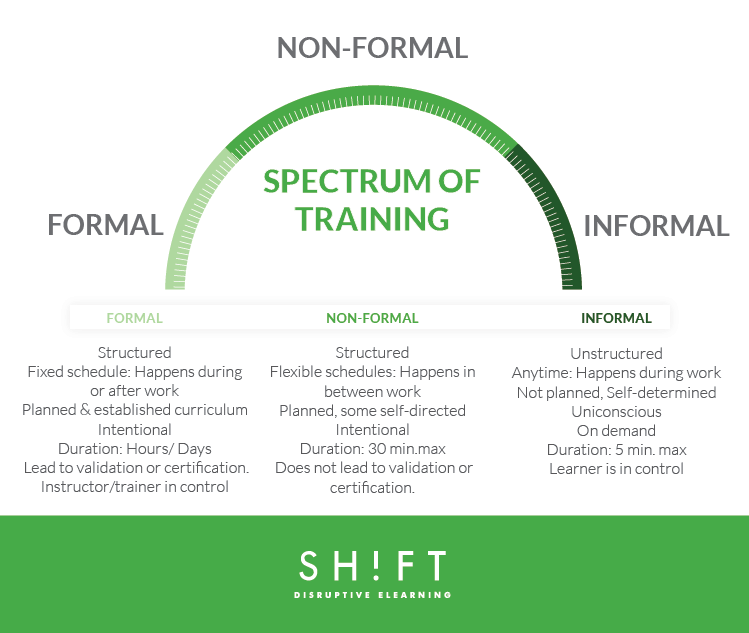While formal learning is still one of the most commonly used training methods in companies, it’s just one way of the many ways of approaching training. In addition to learning formally, individuals can also learn informally and non-formally.
Let’s review these three learning methods, analyze their meaning, depict their main characteristics and discuss examples. After reading this post, you’ll know when and how to best implement each type of learning, and how to combine them to keep your employees engaged and continuously learning. Combining formal, informal and non-formal learning is key to train today’s modern workforce.
Formal Learning
Definition: Formal learning is both the most common and the first route most organizations take to train or educate their employees. It is typically provided in a structured format and is usually planned and intentional by the learner.
Characteristics:
- Objectives and goals are set by the instructor/trainer
- It involves an established curriculum or learning plan with specific duration, content and pre-set methods of assessment.
- Often occurs in group settings, and the schedule and control are maintained by a central authority figure such as an instructor or trainer.
- The main characteristic of this training technique is that it usually leads to a formal qualification, accreditation, certification or professional license and at the end of the course the participant receives a formal recognition such as a certificate, diploma or degree.
- The outcomes are measurable, through some form of assessment, to determine whether the learning objectives have been achieved.
When it works:
- It works especially well when specific and detailed information needs to be gained on a specific timetable.
- It's best suited to situations where a company needs to track employee’s performance. It also simplifies certifying compliance to an external regulator.
- Works well when the target audience is new hires, and require a structured approach to meet learning objectives.
Examples: Formal learning can be through eLearning courses or face-to-face training sessions, and in-person workshops. Examples of formal learning could include anti-money laundering , CPR or safety certifications.
Non-Formal
Definition: Non-formal learning is also typically provided in a structured format, with learning objectives and goals set externally or by the instructor. It’s an intermediate level of learning between formal and informal. It does not have the level of curriculum or external certification associated with formal learning but has more structure than informal learning.
Characteristics:
- It often takes place through a course of instruction, and is intentional by the learner, but differs from formal learning in that it does not lead to external validation or certification.
- Provides flexibility in the organization and methods of learning. It works with a variety of methods, environments, times and situations.
- Is often organized by professional trainers and the activities are planned within the scope of the training.
- Usually, it does not adhere to a strict curriculum and may have diverse methods of assessment.
When it works:
- It can be used to provide insight into a company’s culture, policies or procedures or to hone an employee’s skills. Non-formal learning allows learners to gain a specific knowledge needed to perform their jobs well.
- It’s best for situations where there is required learning material, but no required formal assessment.
Examples: On-the-job training, rapid eLearning programs, video, webinars that are voluntary and do not lead to certification.
Informal Learning
Definition: Informal learning usually results from experience gained through daily activities related to work or recreation. It is not structured in that objectives and goals are not set externally.
Characteristics:
- Is usually incidental, meaning it’s not usually intentional, and it does not lead to certification or external validation.
- Often, informal learning occurs naturally or organically.
- There are no objectives, goals or assessments in informal learning.
- Is often embedded directly into the work processes and procedures, allowing learners to learn and perform simultaneously, which facilitates learning.
- The strength in informal learning lies in its personal approach, ability to disguise learning activities and the low cost of implementation.
When it works: Informal learning’s strength lies in individuals that are self-directed and willing to learn, because it’s not mandatory. Informal learning can be more fun, more practical and provide the tools employees need to implement what they’ve learned on a practical basis. Learning becomes a natural part of a job, and individuals learn without even realizing it, which results in less resistance to learning.
Examples: Some examples of informal learning include coaching, mentoring and conference calls. Group discussions, forums, projects and even just a conversation can also lead to informal learning.
The Right Training Mix
To engage all learners and develop their skills, combining formal learning with informal and non-formal learning is key. Individuals learn best with a combination of all three approaches, as it facilities all aspects of learning.
Coupling the three techniques together provides the best of all training opportunities and allows employees to learn throughout the year and in a variety of settings. Utilizing the different types of learning can keep learners engaged and interested by mixing things up and preventing burn-out.
Don’t think of each category as a separate aspect of your training; think of the three categories as on the spectrum of learning. One end of the spectrum is formal learning, while informal learning is on the other, and non-formal learning is in the middle of the spectrum. It’s important to utilize all aspects of the training range for the most well-rounded employees.
Also read: Why Matching Informal and Formal Learning is in Style
SOURCES:
Using Network and Mobile Technology to Bridge formal and Informal Learningby Guglielmo Trentin; Manuela RepettoPublished by Elsevier Science, 2013
Performance Support at the Moment of Need. Bob Mosher Global Chief Learning Strategy & Strategy Evangelist LearningGuide Solutions, US
Teaching-learning processes between informality and formalization http://www.infed.org/informal_education/informality_and_formalization.htm
Balance between formal and informal learning http://www.nispa.org/files/conferences/2013/papers/201304151202190.Paper_Radakovic.pdf?fs_papersPage=4
Australian Bureau of Statistics: Education and Training Glossary http://www.abs.gov.au/ausstats/abs@.nsf/Lookup/by%20Subject/1370.0~2010~Chapter~Education%20and%20training%20glossary%20(4.2.8)
The Learning Organization: The Hunt for the Right Mix of Learning http://www.cacorpcollege.com/the-learning-organization/
Informal Learning Guide. March, 2015. https://eaprilconference.files.wordpress.com/2014/07/ilg-report.pdf
How Informal Learning Can Enliven a Workplace https://www.recruiter.com/i/how-informal-learning-can-enliven-a-workplace/
Informal Learning and Human Resources https://www.docebo.com/2013/07/26/informal-learning-optimizing-the-development-of-human-resources/
Informal and Formal Learning http://www.knowledgejump.com/learning/informal.html




